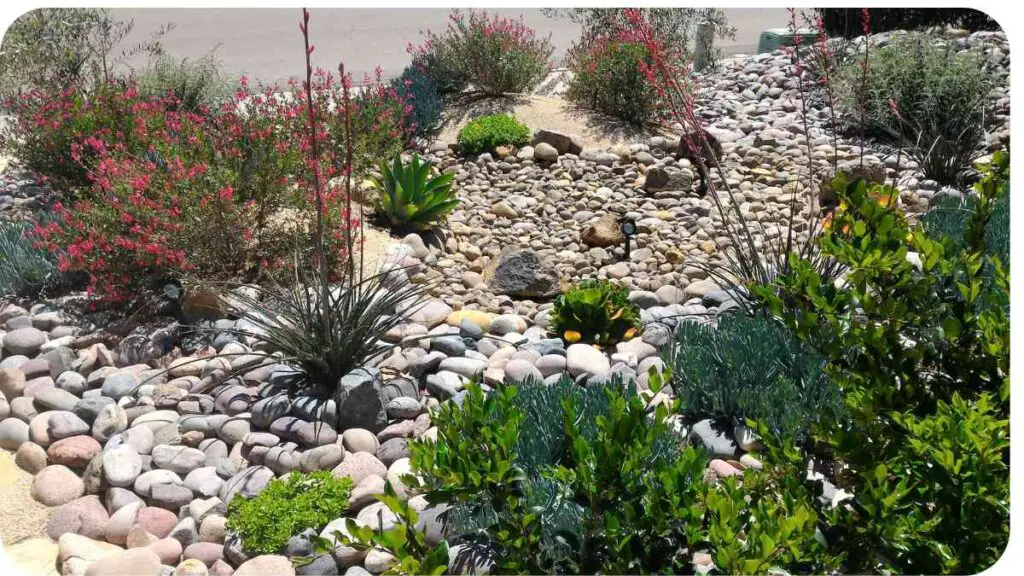Are you looking to create a beautiful and eco-friendly front yard while conserving water? Welcome to the world of xeriscaping! A xeriscape front yard offers a sustainable landscaping solution that reduces water usage without sacrificing aesthetics. In this guide, we’ll delve into what xeriscaping is all about and how you can transform your front yard into a vibrant, water-efficient landscape.
| Takeaway |
|---|
| Xeriscaping offers a sustainable landscaping solution, reducing water usage and maintenance. |
| Choose drought-tolerant plants and efficient irrigation methods for a thriving xeriscape. |
| Proper planning and soil analysis are crucial for successful xeriscape front yards. |
| Regular maintenance ensures the long-term health and beauty of your xeriscape landscape. |
| Xeriscaping allows you to create a stunning and eco-friendly front yard oasis. |
2. Understanding Xeriscaping

Xeriscaping is a landscaping technique focused on creating low-water and drought-tolerant gardens. Originating from the Greek word “xeros” meaning dry, xeriscaping involves careful planning, soil improvement, plant selection, and efficient irrigation to minimize water usage.
Creating a drought-resistant front yard is a smart choice for water conservation. Learn how to build a drought-resistant front yard and save water while maintaining a beautiful landscape.
Benefits of Xeriscaping
Xeriscaping comes with a plethora of benefits for both homeowners and the environment.
3. Benefits of Xeriscaping
Here are some key benefits of xeriscaping:
- Water Conservation: Xeriscaping can reduce water usage by up to 50-75% compared to traditional landscaping.
- Low Maintenance: Once established, xeriscape front yards require less maintenance, saving time and effort.
- Reduced Costs: Lower water bills and decreased maintenance needs result in long-term cost savings.
- Diverse Aesthetics: Xeriscaping offers a variety of plant options, textures, and colors, allowing for beautiful landscapes.
- Environmental Benefits: By conserving water and minimizing chemical usage, xeriscaping promotes environmental sustainability.
Now, let’s see how you can get started with xeriscaping your front yard.
Transforming a sloping front yard into a beautiful landscape is not an easy task, but it can be done. Here’s an ultimate guide on how to landscape a sloping front yard and make the most out of your front yard.
4. Planning Your Xeriscape Front Yard

Before you start digging, it’s essential to plan your xeriscape front yard properly. Here are the key steps:
Soil Analysis Table
| Soil Component | Ideal Content |
|---|---|
| Sand | 50-60% |
| Silt | 20-30% |
| Clay | 10-20% |
| Organic Matter | 5% minimum |
| pH Level | 6.0-7.0 |
Understanding your soil composition helps in plant selection and soil improvement.
Water Availability Table
| Water Source | Availability |
|---|---|
| Rainfall | [Insert data] |
| Municipal Supply | [Insert data] |
| Greywater System | [Insert data] |
| Well Water | [Insert data] |
Knowing your water sources aids in planning irrigation systems.
5. Selecting Drought-Tolerant Plants
Choosing the right plants is crucial for a thriving xeriscape front yard. Here are some drought-tolerant options:
Maximizing your front yard can be a fun and rewarding project. Check out these ideas for outdoor enjoyment and create a space that you and your family will love.
Drought-Tolerant Plant Options Table
| Plant Name | Water Needs | Sunlight Exposure | Height (ft) | Special Features |
|---|---|---|---|---|
| Lavender | Low | Full Sun | 1-3 | Fragrant blooms |
| California Poppy | Low | Full Sun | 1-2 | Colorful flowers |
| Agave | Low | Full Sun | 1-6 | Succulent foliage |
| Russian Sage | Low | Full Sun | 3-5 | Silver-gray foliage |
| Yucca | Low | Full Sun | 2-8 | Architectural structure |
6. Efficient Irrigation Methods
Efficient irrigation is key to xeriscaping success. Let’s compare different irrigation methods:
Comparison of Irrigation Methods Table
| Irrigation Method | Description | Pros | Cons |
|---|---|---|---|
| Drip Irrigation | Delivers water directly to plant roots | Water-efficient, reduces weed growth | Initial setup can be costly |
| Soaker Hoses | Releases water along the length of the hose | Easy to install, reduces water runoff | Requires frequent monitoring |
| Rainwater Harvesting | Collects and stores rainwater for irrigation | Sustainable, reduces water bills | Initial setup cost and space needed |
| Smart Irrigation | Uses sensors to adjust watering based on need | Optimizes water usage, reduces wastage | Higher initial cost, technical setup |
Implementing drip irrigation or soaker hoses can efficiently water your plants while minimizing waste.
7. Mulching Techniques
Mulching is essential in xeriscaping to conserve moisture, suppress weeds, and improve soil health.
Mulch serves as a protective layer over the soil, helping to retain moisture and regulate soil temperature. Here are some mulching materials you can use:
- Organic Mulch: Compost, wood chips, straw.
- Inorganic Mulch: Gravel, pebbles, rocks.
Choose mulch based on your preference and the overall aesthetic you want to achieve in your front yard.
Understanding how much sun your front yard gets is crucial for choosing the right plants and designing a beautiful landscape. Here’s a quick guide on how much sun does my front yard get.
8. Designing Your Xeriscape Front Yard
Designing your xeriscape front yard involves incorporating elements that are both visually appealing and water-efficient.
Xeriscape Design Principles Table
| Design Principle | Description |
|---|---|
| Plant Grouping | Grouping plants with similar water needs conserves water and simplifies care |
| Hardscaping | Use of rocks, pathways, and containers to reduce turf area |
| Water Features | Incorporating water-efficient features like fountains or ponds |
| Native Plants | Utilizing native plants adapted to local climate and soil conditions |
| Focal Points | Adding focal points like sculptures or ornamental trees |
By following these design principles, you can create a visually stunning and water-wise landscape.
9. Maintenance Tips for Xeriscape Front Yards

While xeriscape front yards require less maintenance compared to traditional lawns, they still need care to thrive.
Monthly Maintenance Schedule Table
| Month | Maintenance Tasks |
|---|---|
| March | Prune dead branches, fertilize plants if needed |
| April | Check irrigation system, remove weeds |
| May | Mulch garden beds, monitor for pests and diseases |
| June | Deadhead flowers, adjust irrigation schedule if necessary |
| July | Monitor water usage, trim overgrown plants |
| August | Inspect for signs of drought stress, water as needed |
Regular maintenance ensures your xeriscape remains healthy and beautiful throughout the year.
10. Overcoming Common Challenges
While xeriscaping offers numerous benefits, it’s not without challenges. Here are some common issues and how to overcome them:
- Weed Control: Mulching regularly and hand-pulling weeds can help control weed growth.
- Soil Quality: Amend soil with organic matter to improve its water retention and nutrient content.
- Choosing Plants: Research and select plants suited to your local climate and soil conditions.
- Irrigation Efficiency: Monitor and adjust irrigation systems to prevent over or under-watering.
By addressing these challenges proactively, you can ensure the success of your xeriscape front yard.
Mosquitoes can ruin your outdoor enjoyment and pose a health risk. Learn how to get rid of mosquitoes in your front yard with these simple and effective tips.
11. Examples of Stunning Xeriscape Front Yards
Seeing real-life examples can provide inspiration for your own xeriscape front yard. Here are a few stunning examples:
- Desert Oasis Front Yard:
- Plant Selection: Succulents like agave and cacti create a desert landscape.
- Hardscaping: Decorative rocks and gravel pathways reduce water usage.
- Water Feature: Small desert-themed fountain adds ambiance without excessive water consumption.
- Mediterranean Paradise:
- Plants: Mediterranean herbs like lavender and rosemary provide fragrance and color.
- Design: Terra cotta pots and tiled pathways evoke a Mediterranean feel.
- Mulching: Gravel mulch around plants conserves moisture and complements the theme.
- Modern Xeriscape Design:
- Minimalist Approach: Simple plantings with clean lines for a modern aesthetic.
- Paving: Large concrete pavers with drought-tolerant ground cover between them.
- Sculptural Elements: Incorporation of metal sculptures for visual interest.
- Woodland Retreat:
- Native Plants: Shade-loving native plants create a woodland feel.
- Mulch: Shredded bark mulch retains moisture and enriches the soil.
- Pathway: Meandering gravel pathway adds charm and requires minimal watering.
12. Conclusion
Xeriscaping your front yard is not only environmentally friendly but also adds beauty and value to your home. By following the principles of xeriscaping and choosing the right plants and design elements, you can create a stunning landscape while conserving water and reducing maintenance.
Remember, xeriscaping is a journey, and it may take time to establish your ideal landscape. Start small, plan carefully, and enjoy the process of creating a sustainable oasis right in front of your home.
Further Reading
Here are some additional resources to further explore xeriscaping:
- Xeriscaping: A Complete Guide: Detailed guide covering all aspects of xeriscaping, from planning to plant selection.
- How to Xeriscape Your Yard: Step-by-step instructions for xeriscaping your yard while saving money and water.
- Xeriscape Ideas: Creating a Water-Efficient Landscape: Inspirational ideas and tips for designing your xeriscape front yard.
FAQs
What is xeriscaping?
Xeriscaping is a landscaping method focused on creating water-efficient gardens by using drought-tolerant plants and efficient irrigation techniques.
Is xeriscaping only for dry climates?
While xeriscaping originated in arid regions, its principles can be applied in various climates to conserve water and reduce maintenance.
Do I need special soil for xeriscaping?
Xeriscaping can adapt to different soil types, but improving soil with organic matter can enhance water retention and plant health.
How much water does xeriscaping save?
Xeriscaping can reduce water usage by up to 50-75% compared to traditional landscaping methods.
Are there any government incentives for xeriscaping?
Some regions offer rebates or incentives for xeriscaping projects as part of water conservation initiatives. Check with local authorities for available programs.
How do I maintain a xeriscape front yard?
Regular maintenance tasks include watering as needed, mulching, occasional pruning, and monitoring for pests or diseases.

Hi! My name is Hellen James, and I’m here to help you with your home-maintenance needs. Whether it’s building a better yard or just trying to fix a garden—I can show you how.

